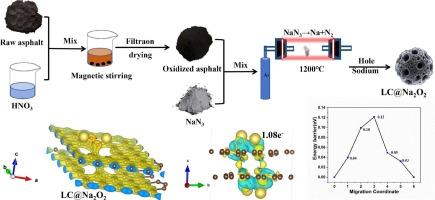Coupled pore-forming and sodium supplementation strategies for asphalt-based hard carbon anodes to enhance the cycling stability of sodium-ion batteries
IF 4.6
3区 材料科学
Q2 MATERIALS SCIENCE, MULTIDISCIPLINARY
引用次数: 0
Abstract
Due to its low cost, high aromaticity, and easy polycondensation, petroleum-based asphalt is an ideal precursor for preparing high-value-added hard carbon sodium-ion battery anode materials. However, the relatively low coulombic efficiency of these anodes has restricted their development. Herein, NaN3 was introduced during the asphalt carbonization process to load Na2O2 nanocrystals and generate a large number of pore structures on the surface of the resulting hard carbon. This led to a 45.8 % increase in the specific surface area and enhanced the sodium storage performance of the asphalt-based hard carbon anode. The average discharge specific capacity of the modified anode at 30 mA·g−1 was 346.3 mAh·g−1, demonstrating excellent sodium storage performance. Moreover, modification with NaN3 provided an initial coulombic efficiency (ICE) of up to 92.2 %, which was much higher than that of the base hard carbon sample (67.5 %). DFT theoretical calculations reveal a transition barrier of 0.12 eV, where Na and C lose electrons while O gains electrons.The modified anode material prepared by the coupled pore-forming and sodium supplementation process has a high specific capacity and good fast charging performance, enhancing the overall battery performance and helping promote the commercial application of sodium-ion batteries.

提高钠离子电池循环稳定性的沥青基硬碳阳极耦合成孔补钠策略
石油基沥青具有成本低、芳香性高、易缩聚等优点,是制备高附加值硬碳钠离子电池负极材料的理想前驱体。然而,这些阳极相对较低的库仑效率限制了它们的发展。本文在沥青炭化过程中引入NaN3来加载Na2O2纳米晶体,并在生成的硬碳表面产生大量的孔隙结构。这使得沥青基硬碳阳极的比表面积增加了45.8%,并提高了钠的储存性能。改性阳极在30 mA·g−1条件下的平均放电比容量为346.3 mAh·g−1,具有优异的储钠性能。此外,用NaN3修饰后,其初始库仑效率(ICE)高达92.2%,远高于基体硬碳样品的67.5%。DFT理论计算揭示了一个0.12 eV的跃迁势垒,其中Na和C失去电子,而O获得电子。通过成孔补钠耦合工艺制备的改性负极材料具有较高的比容量和良好的快速充电性能,提高了电池的整体性能,有助于促进钠离子电池的商业化应用。
本文章由计算机程序翻译,如有差异,请以英文原文为准。
求助全文
约1分钟内获得全文
求助全文
来源期刊

Materials Science and Engineering: B
工程技术-材料科学:综合
CiteScore
5.60
自引率
2.80%
发文量
481
审稿时长
3.5 months
期刊介绍:
The journal provides an international medium for the publication of theoretical and experimental studies and reviews related to the electronic, electrochemical, ionic, magnetic, optical, and biosensing properties of solid state materials in bulk, thin film and particulate forms. Papers dealing with synthesis, processing, characterization, structure, physical properties and computational aspects of nano-crystalline, crystalline, amorphous and glassy forms of ceramics, semiconductors, layered insertion compounds, low-dimensional compounds and systems, fast-ion conductors, polymers and dielectrics are viewed as suitable for publication. Articles focused on nano-structured aspects of these advanced solid-state materials will also be considered suitable.
 求助内容:
求助内容: 应助结果提醒方式:
应助结果提醒方式:


